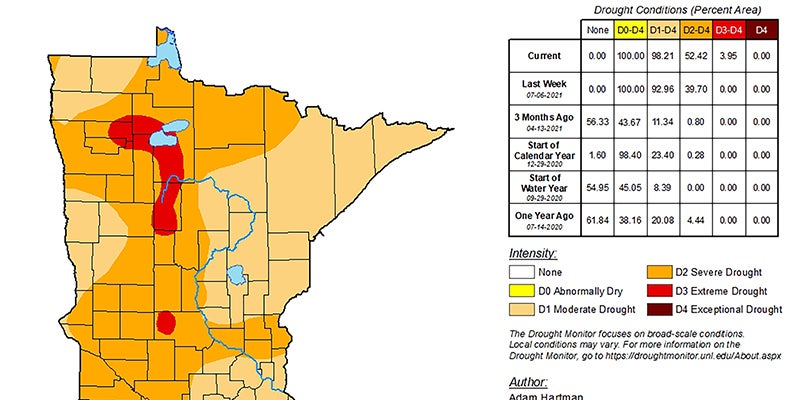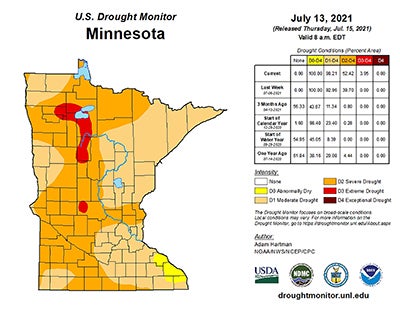Minnesota enters drought warning phase
Published 5:39 pm Friday, July 16, 2021
|
Getting your Trinity Audio player ready...
|
With 52% of Minnesota now experiencing severe drought and 4% in extreme drought, the state has entered the drought warning phase, the Minnesota Department of Natural Resources announced on Friday.
With this designation, the DNR and others are taking additional steps. Current drought information, including details on areas subject to surface water use suspensions, is available on DNR’s website.
The warning phase for drought occurs when a significant portion of the state passes thresholds for severe drought conditions at major watersheds. The warning phase for public water suppliers using the Mississippi River is also triggered when stream flows in the Twin Cities Metropolitan Area have dropped below designated levels, which is expected to happen in the coming days. The thresholds for drought watch and warning conditions are specified in the Minnesota Statewide Drought Plan.
Under current conditions, it will take at least three to five inches of precipitation spread over a period of about two weeks to significantly alleviate the drought. Soils are more efficiently replenished by multiple rainfall events than by any single heavy rainfall event. Surface water and groundwater respond somewhat differently over time.
Drought is a naturally occurring feature of Minnesota’s climate. Some level of moderate and severe drought typically occurs in the state almost every year for at least a few weeks. Most severe drought in Minnesota is short-lived, but drought in Minnesota does occasionally enter the extreme intensity classification.
Minnesotans are encouraged to learn how much water they are using compared to the average American home and identify ways to reduce water use now and in the future. More than 75% of Minnesotans rely on groundwater for their water supply. Reducing use today saves water for the future.
“One area in which drought can be very apparent to Minnesotans is the fluctuation of water levels in lakes, rivers and streams,” said Katie Smith, director of DNR’s Ecological and Water Resources division. “What people may not realize is that DNR and other government agencies only manage a relatively small number of lakes and rivers with water control structures, and these operate under specific management plans. So the vast majority of Minnesota’s waters are subject to natural fluctuations.”
Lakes, streams, and rivers are dependent on the amount of precipitation an area receives, how much of that moisture is contributed by runoff, how much water is recharged or discharged through groundwater, and how much water evaporates.
More information about drought is available on the DNR website. The website includes a link where anyone can sign up to receive drought-related notifications and information.







